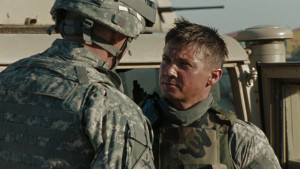The best movies don’t often present objective glimpses into unique situations, but take the time to look deeper into their character’s minds. Likewise, the best war movies – often the fodder for Oscar nominations come award time – don’t force-feed audiences bravery and patriotism, but examine soldiers as human beings, questioning not only why they risk their lives, but the effect the harrowing and violent arena of war has on even the toughest soldiers. Predating Director Kathryn Bigelow’s chronicle of the raid on Osama bin Laden in “Zero Dark Thirty,” her 2008 war drama “The Hurt Locker” is such a film – a focused and effective look at a U.S. bomb disposal squad stationed in Iraq during the Middle East conflict.
When the movie opens, we are given short notice to accept the fact that this is a very dangerous job. These men work in threes: One man keeps watch, another is sidelined to assist, and the third walks right into hell’s kitchen, approaching suspected bombs in large, clunky-looking suits meant to deflect shrapnel but certainly not a full blast. These men are precision bomb-disarmers, rightly called “Specialists” by the Army. However, the word is thrown around not like a title, but like a sentence, worn by men who realize that every time they suit up is a matter of life and death. Sgt. Sanborn, the lookout, realizes this intuitively. However, by the look on the face of his partner, Specialist William James, we’re not so sure he realizes it at all.
These two men are the crux of the film, played expertly by Jeremy Renner and Anthony Mackie. Mackie’s Sanborn is a man who’s been doing this for a while and is not sure he wants to continue; Renner’s James is a man addicted to the job who doesn’t know if he can stop. James’ predecessor was killed in an explosion while defusing a bomb, showing the frailty of their so-called ‘protective suits.’ But James is reckless; discovering a trunk full of bombs with enough capacity to level an entire block, he strips off his suit, helmet, and protective vest. “If I’m going to die, I want to at least be comfortable,” he scoffs.

“The Hurt Locker” is an engrossing movie due to its narrow focus, tension, and thorough character development. It doesn’t feature epic battles to rival the raid on Normandy beach as in “Saving Private Ryan,” nor is it littered with protracted scenes of nauseating war injuries such as in “Black Hawk Down.” The casualty rate is low-to-moderate, but there is a certain emotional distance kept from the proceedings, the result of a movie told through soldiers’ eyes. The loss of lives is kept in check by these men, sandwiched between bravado, cockiness, and questions never asked.
“Locker’s” soldiers deal with this in different ways. Specialist Owen Eldridge (Brian Geraghty, “Flight“) chokes his fright with menial tasks such as cleaning off bullets stained with blood and communicating between specialists and sentries. Sanborn counts down the days until their Company can leave their post in Iraq, questioning in equal measure why he risks his life and whether or not he has what it takes to wear the protective suit himself. There is a scene between James and Sanborn, where he asks this, though we’re not sure exactly why. He’s not a Specialist, but a soldier – and he’s very good at what he does.
There is a purpose, and immediacy to James that comes out when he is doing his job, affected by almost nothing. He almost dies? No problem. He loses a partner? No problem. However, it is in the most understated circumstances – such as his desire to properly bury an innocent Iraqi child – that shows humanity seeping through his chain mail line of defense. Eldridge accuses him of being a great warrior, but not being good with people.
However, scenes during “The Hurt Locker” – in particular a protracted scene where James sits in a shower in full uniform, broken – show an effect of war upon him that is deep and possibly irreversible. The thrill of the hunt is what makes him tick. But what does that leave when there’s nothing left to hunt? The movie asks this question elusively, never providing a definitive answer. Sometimes people do things because they need something in return; but sometimes they do them for another reason: because it’s all they know.
“The Hurt Locker” is a captivating movie. In a sea of battle-soaked war epics, its focus and character exploration makes it a standout unique, helmed wonderfully by Kathryn Bigelow. The performances are top of the line, with special note to Renner, who truly brings James to life with realism, tragedy, and charm. It features an excellent cast, stellar directing, and tension and suspense that should please fans of war movies or anyone looking for a well-crafted drama. The film walked away with several Academy Awards, including ‘Best Motion Picture,’ and saw Bigelow being the first woman to win ‘Best Director.’ Whether curious if “The Hurt Locker” lives up to this hype or you’re just looking for a good movie to rent, you’ll doubtless find an enthralling story on par with some of the most captivating war films to date.
– by Mark Ziobro
3 Comments
one great review
I really enjoyed this film. Kathryn Bigelow is a solid director.
Pingback: » Zero Dark Thirty (R)